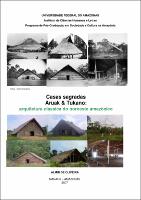| ???jsp.display-item.social.title??? |


|
Please use this identifier to cite or link to this item:
https://tede.ufam.edu.br/handle/tede/2282| ???metadata.dc.type???: | Dissertação |
| Title: | Casas sagradas Aruak & Tukano: arquitetura clássica do noroeste amazônico |
| ???metadata.dc.creator???: | Oliveira, Almir de  |
| ???metadata.dc.contributor.advisor1???: | Braga, Sérgio Ivan Gil |
| ???metadata.dc.description.resumo???: | As manifestações arquitetônicas dos povos autóctones no Brasil não encontram lugar na teoria e história da arquitetura brasileira, é como se não tivessem contribuição a oferecer, enquanto modelos de estabilidade, conforto e beleza; que é o que na verdade são. Ao percorrer algumas bacias hidrográficas da Amazônia, essa sempre foi uma questão que despertou meu interesse de arquiteto. Trabalhando com o patrimônio cultural junto ao Instituto Patrimônio Histórico e Artístico Nacional (IPHAN), aqui na Amazônia, indagava-me sobre essa lacuna na esfera de interesses do Ministério da Cultura. O rio Negro é locus da pesquisa que comecei a desenvolver com essas inquietações em mente. A princípio, era o patrimônio imaterial o objeto de interesse mais amplo, que logo foi direcionado para as casas-aldeias, habitações indígenas tradicionais dos povos de língua Aruak e Tukano, como foram descritas por etnólogos que se dedicaram ao estudo da cultura material. Os desdobramentos desses trabalhos, ao longo dos últimos sete anos, ampliaram a rede de parceiros. Como assessor do Instituto Socioambiental (ISA), organização não governamental, realizei atelieres de arquitetura, junto a comunidades indígenas, tendo como objeto as casas-aldeias no noroeste Amazônico: um atelier em 2005, entre os Tuyuka no alto rio Tiquié, tributário do rio Uaupés e outro atelier em Iauaretê A Cidade do Índio , em 2007 no Centro Cultural Tariano. Assumindo uma perspectiva etnográfica, elaboro narrativas desses eventos e desenvolvo uma abordagem, considerando temporalidades distintas para revelar o sentido das casas-aldeias na atualidade. A ótica do arquiteto perpassa pela teoria e história da arquitetura que permite pensar a produção do espaço e tempo; e o próprio sentido da arquitetura através dessas casas-aldeias que guardam em si uma visão de mundo. |
| Abstract: | The architectonic manifestations of the autochthonous people in Brazil do not find a place in the theories and History of Brazilian architecture, it s as if they had no contribution to offer as models of stability, comfort, and beauty which is what they are. As I traveled around some hydrographic bays of the Amazon that has always been an issue that arouse my interest as an architect. I work with the IPHAN (Historic and National Artistic Heritage Institute), here in the Amazon, and I asked myself about this gap in the sphere of interest of the Ministry of Culture. The Black River is the research s locus which I began developing with these on, which soon was directed to the house-villages, indigenous traditional in habitations of the Aruak and Tukano speaking people, which were described by the ethnologists who dedicated themselves to the study of material culture. The outcome of these works throughout these seven years broadened the net of partners. As the Socioambiental Institute adviser I made many architecture workshops with the indigenous communities, having as object the house-villages in the northwestern Amazon: a workshop in 2005 among the Tuyuka in the upper Tiquié River, a tributary of the Uaupés River; and another workshop in Iauaretê, the City of the Indian , in 2007 at the Tariano Cultural Center. Taking on an ethnographic perspective, I drew up narratives of these events and I developed an approach considering distinct temporalities to reveal the sense of housevillages nowadays. The optic of the architect passes through the theory and History of architecture, which allows us to think on the production of space and time, and the sense of architecture itself through these house-villages which keep in themselves a vision of the world. |
| Keywords: | Arquitetura Aruak Tukano Habitação indígena Espaço tempo Architecture Aruak Tukano Indigenous habitations Space and Time |
| ???metadata.dc.subject.cnpq???: | OUTROS |
| Language: | por |
| ???metadata.dc.publisher.country???: | BR |
| Publisher: | Universidade Federal do Amazonas |
| ???metadata.dc.publisher.initials???: | UFAM |
| ???metadata.dc.publisher.department???: | Instituto de Ciências Humanas e Letras |
| ???metadata.dc.publisher.program???: | Programa de Pós-Graduação em Sociedade e Cultura na Amazônia |
| Citation: | OLIVEIRA, Almir de. Casas sagradas Aruak & Tukano: arquitetura clássica do noroeste amazônico. 2007. 162 f. Dissertação (Mestrado em Sociedade e Cultura na Amazônia) - Universidade Federal do Amazonas, Manaus, 2007. |
| ???metadata.dc.rights???: | Acesso Aberto |
| URI: | http://tede.ufam.edu.br/handle/tede/2282 |
| Issue Date: | 13-Nov-2007 |
| Appears in Collections: | Mestrado em Sociedade e Cultura na Amazônia |
Files in This Item:
| File | Description | Size | Format | |
|---|---|---|---|---|
| Dissertação - Almir de Oliveira.pdf | Dissertação - Almir de Oliveira.pdf | 6.7 MB | Adobe PDF |  Download/Open Preview |
Items in DSpace are protected by copyright, with all rights reserved, unless otherwise indicated.




